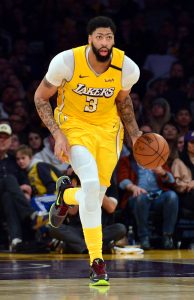Now that the NBA has set its salary cap for the 2020/21 league year at $109,140,000, we have a clear idea of what maximum-salary contracts will look like for the coming season. Conveniently, with the cap unchanged from 2019/20, this year’s max deals will look a whole lot like last year’s.
 We’ll likely soon be able to apply these numbers to contracts for free agents Anthony Davis and Brandon Ingram. They’re also relevant for players who signed maximum-salary extensions in 2019 that will go into effect in ’20/21, such as Jamal Murray.
We’ll likely soon be able to apply these numbers to contracts for free agents Anthony Davis and Brandon Ingram. They’re also relevant for players who signed maximum-salary extensions in 2019 that will go into effect in ’20/21, such as Jamal Murray.
Listed below are the maximum-salary contracts for players signing contracts that start in 2020/21. The first chart shows the maximum salaries for a player re-signing with his own team — a player’s previous team can offer five years instead of four, and 8% annual raises instead of 5% raises. The second chart shows the maximum salaries for a player signing with a new team.
A player’s maximum salary is generally determined by his years of NBA experience, so there’s a wide gap between potential earnings for younger and older players. In the charts below, the “6 years or less” column details the maximum contracts for players like Ingram and Murray; the “7-9 years” column applies to free agents like Davis; and the “10+ years” column applies to the league’s most experienced vets, none of whom are particularly strong candidates for max deals this fall.
Here are the maximum salary figures for 2020/21:
A player re-signing with his own team (8% annual raises, up to five years):
| Year | 6 years or less | 7-9 years | 10+ years |
|---|---|---|---|
| 2020/21 | $27,285,000 | $32,742,000 | $38,199,000 |
| 2021/22 | $29,467,800 | $35,361,360 | $41,254,920 |
| 2022/23 | $31,650,600 | $37,980,720 | $44,310,840 |
| 2023/24 | $33,833,400 | $40,600,080 | $47,366,760 |
| 2024/25 | $36,016,200 | $43,219,440 | $50,422,680 |
| Total | $158,253,000 | $189,903,600 | $221,554,200 |
A player signing with a new team (5% annual raises, up to four years):
| Year | 6 years or less | 7-9 years | 10+ years |
|---|---|---|---|
| 2020/21 | $27,285,000 | $32,742,000 | $38,199,000 |
| 2021/22 | $28,649,250 | $34,379,100 | $40,108,950 |
| 2022/23 | $30,013,500 | $36,016,200 | $42,018,900 |
| 2023/24 | $31,377,750 | $37,653,300 | $43,928,850 |
| Total | $117,325,500 | $140,790,600 | $164,255,700 |
There’s also one last category of maximum salary worth outlining for 2020/21. Sixers guard/forward Ben Simmons and Raptors forward Pascal Siakam both signed rookie scale extensions last year that would have been worth the maximum allowable starting salary for players with their experience level (25% of the cap).
However, because Rose Rule language was written into each player’s contract, and both Simmons and Siakam made All-NBA teams in 2020, they’ll be eligible for a slightly higher starting salary worth 28% of the cap. It’s a sort of pseudo-max, since the two stars could technically have received up to 30% of the cap in 2020/21 if they’d made the All-NBA First Team.
Here’s what Simmons’ five-year deal and Siakam’s four-year pact will look like:
| Year | Ben Simmons | Pascal Siakam |
|---|---|---|
| 2020/21 | $30,559,200 | $30,559,200 |
| 2021/22 | $33,003,936 | $33,003,936 |
| 2022/23 | $35,448,672 | $35,448,672 |
| 2023/24 | $37,893,408 | $37,893,408 |
| 2024/25 | $40,338,144 | — |
| Total | $177,243,360 | $136,905,216 |
Finally, it’s worth noting that none of the maximum-salary figures listed above will apply to extension-eligible players whose new contracts would start in 2021/22.
This group includes players like Giannis Antetokounmpo, who is eligible for a super-max extension with the Bucks. It also includes veterans who have already signed maximum-salary extensions, like Damian Lillard with the Trail Blazers, and players who could sign rookie scale extensions in the coming weeks, such as Celtics forward Jayson Tatum and Kings guard De’Aaron Fox.
Even if they sign new deals sooner rather than later, the exact value of their next contracts will depend on where the cap lands for ’21/22. The NBA has announced that the cap for next year could increase anywhere from 3-10% on this season’s figure, so there’s still a wide range of possible values for those future deals.
Photo courtesy of USA Today Sports Images.